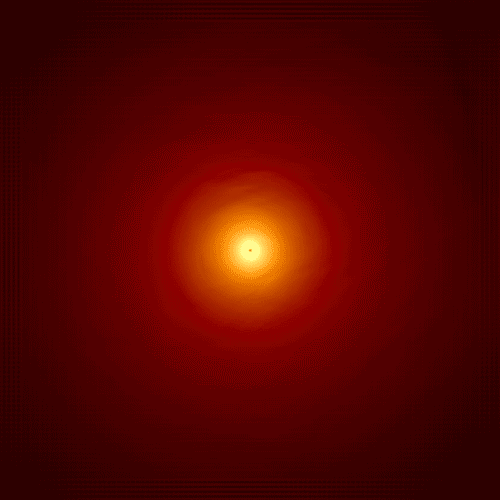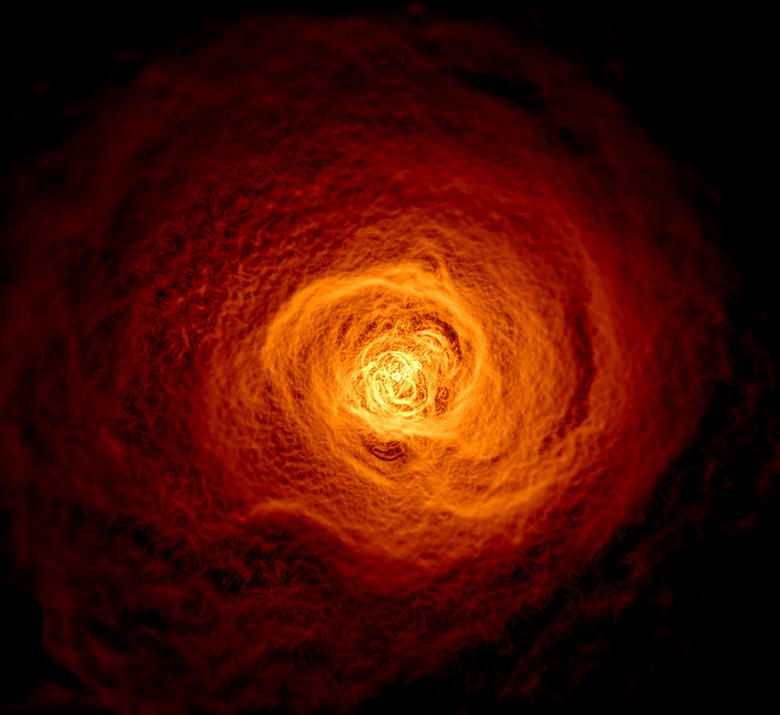Featured Articles
You Are Here
Cosmic perspective viewed millions of times, translated to more than twenty languages, and prescribed by medical doctors as a treatment for depression.
The Story of Bobby
A story about a fragile boy named Bobby who wasn't liked by his friends, did poorly in school, and was ridiculed throughout his life.
Give Me Space Exploration Or Give Me Death
Nevermind my usual, overly idealistic and romantic arguments for why we should explore the universe. Here's one that I imagine most people will agree with: Cataclysmic impacts by space debris.
The Sun Compared to Other Stars
In this picture, the Sun, which is 109 times larger (in diameter) than the Earth, is represented by a single pixel. How positively mind-boggling to consider.
Most Recent Articles
A Giant Wave in Perseus

Credit: Credit: John ZuHone/Harvard-Smithsonian Center for Astrophysics.
Combining data from NASA’s Chandra X-ray Observatory with radio observations and computer simulations, scientists have found a vast wave of hot gas in the Perseus galaxy cluster. Spanning some 200,000 light years, the wave is about twice the size of the Milky Way galaxy.
Researchers think the wave formed billions of years ago after a small galaxy cluster grazed Perseus and caused its vast supply of gas to slosh around in an enormous volume of space.
Galaxy clusters are the largest structures bound by gravity in the universe today. Some 11 million light years across and located about 240 million light years away, the Perseus galaxy cluster is named after its host constellation. Like all galaxy clusters, most of its observable matter takes the form of a pervasive gas averaging tens of millions of degrees — so hot it only glows in X-rays.
Cassini's Grand Finale
To help visualize the dramatic final chapter in Cassini’s remarkable story, NASA’s Jet Propulsion Laboratory produced this short film that features beautiful computer-generated animation, thoughtful narration and a rousing score. Producers at JPL worked with filmmaker Erik Wernquist, known for his 2014 short film “Wanderers,” to create a stirring finale video befitting one of NASA’s most successful missions of exploration.
Wernquist’s signature animation style uses real images from space missions as a starting point, which gives the resulting animations an uncanny authenticity. In addition, the vistas he creates have an uncommonly powerful sense of scale that conveys the vastness of the planetary locales NASA spacecraft have visited.
via NASA/JPL
The Moon Rotating
A huge payoff from the longevity of the LRO mission is the repeat coverage obtained by the LROC Wide Angle Camera (WAC). The WAC has a very wide field-of-view (FOV), 90° in monochrome mode and 60° in multispectral mode, hence its name. On the one hand, the wide FOV enables orbit-to-orbit stereo, which allowed LROC team members at the DLR to create the unprecedented 100 meter scale near-global (0° to 360° longitude and 80°S to 80°N latitude) topographic map of the Moon (the GLD100)!
It looks like rendered computer graphics, but it’s just physics, as SonicSubculture on Reddit points out:
It’s actually not distorted or unrealistic at all – it’s just UNLIT and it’s messing with everybody’s vision because we’re so used to seeing specular highlights and shading on spheres. Features are advancing as expected on a sphere, but it’s lit as though it’s a flat circle - or as though every point has an even level of illumination.
Another thing people are pointing out is about how perfectly spherical it is. At this scale, everything looks like a perfect sphere, thanks to our old pal big G – gravity!
via NASA/ASU
When Jovian Light and Dark Collide
This image, taken by the JunoCam imager on NASA’s Juno spacecraft, highlights a feature on Jupiter where multiple atmospheric conditions appear to collide.
This publicly selected target is called “STB Spectre.” The ghostly bluish streak across the right half of the image is a long-lived storm, one of the few structures perceptible in these whitened latitudes where the south temperate belt of Jupiter would normally be. The egg-shaped spot on the lower left is where incoming small dark spots make a hairpin turn.
The image was taken on March 27, 2017, at 2:06 a.m. PDT (5:06 a.m. EDT), as the Juno spacecraft performed a close flyby of Jupiter. When the image was taken, the spacecraft was 7,900 miles (12,700 kilometers) from the planet.
The image was processed by Roman Tkachenko, and the description is from John Rogers, the citizen scientist who identified the point of interest.
via NASA
Samsara
After an alien species picks up the Voyager spacecraft and decodes the golden record, they’ll want more material to discover our differences and similarities.
Can we send out another spacecraft with a copy of Samsara?
Prepare yourself for an unparalleled sensory experience. SAMSARA reunites director Ron Fricke and producer Mark Magidson, whose award-winning films BARAKA and CHRONOS were acclaimed for combining visual and musical artistry.
SAMSARA is a Sanskrit word that means “the ever turning wheel of life” and is the point of departure for the filmmakers as they search for the elusive current of interconnection that runs through our lives. Filmed over a period of almost five years and in twenty-five countries, SAMSARA transports us to sacred grounds, disaster zones, industrial sites, and natural wonders. By dispensing with dialogue and descriptive text, SAMSARA subverts our expectations of a traditional documentary, instead encouraging our own inner interpretations inspired by images and music that infuses the ancient with the modern.
Expanding on the themes they developed in BARAKA (1992) and CHRONOS (1985), SAMSARA explores the wonders of our world from the mundane to the miraculous, looking into the unfathomable reaches of man’s spirituality and the human experience. Neither a traditional documentary nor a travelogue, SAMSARA takes the form of a nonverbal, guided meditation. Through powerful images, the film illuminates the links between humanity and the rest of nature, showing how our life cycle mirrors the rhythm of the planet.
Honorable mention to Koyaanisqatsi, Chronos, and Baraka , all by the same author, Ron Fricke.

